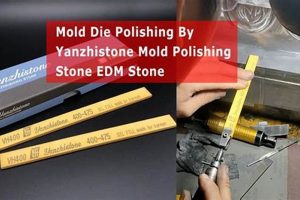Aluminum that undergoes specialized processing to achieve a highly reflective surface is often used in various applications. This treatment results in a material possessing a polished sheen comparable to that of a glass mirror. One example is its utilization in decorative trim for architectural applications, where its reflective properties enhance visual appeal.
The adoption of this particular aluminum treatment offers several advantages, including enhanced aesthetics and increased reflectivity. Historically, achieving such a refined surface required laborious manual polishing. Modern techniques have streamlined the process, making it more efficient and cost-effective. The reflective properties contribute to improved lighting efficiency in certain applications, such as reflectors in light fixtures.
The following sections will delve into specific manufacturing methods, explore diverse applications across industries, and analyze the factors influencing the cost and maintenance of highly reflective aluminum surfaces.
Tips for Working with Highly Reflective Aluminum
The following recommendations are intended to optimize the handling, processing, and application of aluminum surfaces with a polished, mirror-like finish. Adhering to these guidelines can help prevent damage, maintain aesthetic quality, and ensure optimal performance.
Tip 1: Minimize Surface Contact During Handling: Abrasive materials and even fingerprints can readily mar the highly reflective surface. Employ clean, lint-free gloves and utilize vacuum handling equipment where feasible.
Tip 2: Employ Suitable Cutting Techniques: Laser cutting or waterjet cutting are preferred methods for minimizing edge burrs and maintaining the integrity of the finish. Mechanical cutting methods should be carefully evaluated to mitigate the risk of scratches or deformation.
Tip 3: Select Compatible Cleaning Agents: Avoid harsh chemicals or abrasive cleaners. Opt for pH-neutral solutions specifically designed for aluminum and test them on a small, inconspicuous area first to assess compatibility.
Tip 4: Implement Proper Storage Procedures: Store the material in a clean, dry environment, protected from dust, moisture, and physical damage. Consider interleaving with acid-free paper or polyethylene film to prevent scratching during storage and transport.
Tip 5: Consider Protective Coatings: Apply a clear, protective coating, such as a specialized lacquer or anodized layer, to enhance resistance to abrasion, oxidation, and environmental contaminants. Select a coating compatible with the intended application and environmental conditions.
Tip 6: Implement Quality Control Measures: Establish rigorous inspection protocols at each stage of processing to identify and address any imperfections in the surface finish promptly. This includes visual inspection under controlled lighting and potentially, surface roughness measurements.
Adhering to these tips will aid in preserving the high-quality finish and maximizing the lifespan of aluminum with a reflective surface. Careful handling and appropriate processing techniques are essential for realizing the full potential of this versatile material.
The subsequent sections will focus on the cost considerations and sustainability aspects associated with utilizing this specialized aluminum finish in various industries.
1. Reflectivity Enhancement
Reflectivity enhancement is a primary objective in the production of mirror finish aluminum. The process aims to maximize the amount of light reflected from the aluminum surface, approaching the reflectance levels observed in glass mirrors. This is achieved through a combination of mechanical and chemical treatments designed to reduce surface irregularities at a microscopic level. Surface imperfections scatter light, diminishing reflectivity; therefore, the smoother the surface, the higher the reflectance. This enhanced reflectivity is not merely aesthetic; it is crucial in applications such as solar reflectors, where maximizing light capture directly correlates to increased energy production. Similarly, in lighting fixtures, a highly reflective aluminum surface significantly improves light output efficiency.
The practical significance of understanding the connection between processing techniques and reflectivity enhancement lies in the ability to tailor the aluminum finish to specific application requirements. For instance, different polishing methods yield varying degrees of reflectivity, each suited to different needs. Electrochemical polishing, for example, provides a higher degree of reflectivity than simple mechanical polishing, making it preferable for applications requiring optimal light reflection. Anodizing after polishing, though potentially reducing initial reflectivity by a small margin, can greatly increase the longevity of the reflective surface by providing a protective layer against corrosion and abrasion. Without a clear understanding of these trade-offs, designers risk selecting materials that compromise performance or durability.
In summary, reflectivity enhancement is an essential component of mirror finish aluminum, dictating its suitability for various applications. Optimizing this characteristic requires careful consideration of processing techniques, balancing initial reflectivity with long-term durability and performance. The challenges lie in precisely controlling the surface finish to meet specific performance requirements and environmental conditions, while maintaining cost-effectiveness. Further research and development in polishing and coating technologies are essential to further improve the performance and expand the application of mirror finish aluminum.
2. Surface Smoothness
Surface smoothness is a critical determinant of the reflective quality in mirror finish aluminum. The extent to which a surface approaches perfect planarity directly influences its ability to reflect light uniformly and without distortion, thus achieving a mirror-like appearance.
- Minimizing Light Scattering
Surface irregularities, even at the microscopic level, cause light to scatter rather than reflect specularly. A rough surface presents countless tiny facets, each reflecting light in a different direction. The smoother the surface, the greater the proportion of light reflected in a single, coherent direction, producing a clear, undistorted reflection. Examples of applications where minimizing light scattering is paramount include scientific instruments and precision optical components.
- Impact of Polishing Techniques
The techniques employed to polish aluminum directly impact its final surface smoothness. Mechanical polishing involves the use of abrasive compounds to gradually remove surface imperfections. Electropolishing, an electrochemical process, dissolves surface atoms, resulting in an exceptionally smooth surface. The choice of polishing technique depends on the required level of smoothness and the intended application. For instance, electropolishing is often preferred for applications requiring high reflectivity and minimal surface defects.
- Measurement and Characterization
Surface smoothness is quantitatively measured using parameters like surface roughness (Ra) and root mean square roughness (Rq). These parameters provide a statistical measure of the vertical deviations of the surface from a mean plane. Lower Ra and Rq values indicate a smoother surface. Specialized instruments, such as atomic force microscopes (AFM) and profilometers, are used to characterize surface smoothness and ensure compliance with specified requirements. Strict quality control measures are essential to maintain the required level of smoothness during manufacturing.
- Durability Considerations
While achieving high surface smoothness is critical for reflectivity, it can also affect the material’s durability. An extremely smooth surface may be more susceptible to scratching and damage from handling. Therefore, protective coatings, such as thin films or anodized layers, are often applied to enhance durability without significantly compromising reflectivity. Balancing the need for smoothness with the need for durability is a key challenge in the production of mirror finish aluminum.
The interplay between surface smoothness, polishing techniques, measurement methods, and durability considerations underscores the complexity of achieving and maintaining a mirror finish on aluminum. Precise control over these factors is essential to optimize the material’s reflective properties and ensure its suitability for a wide range of demanding applications.
3. Optical Precision
Optical precision, in the context of mirror finish aluminum, refers to the accuracy with which the reflective surface replicates the geometry of incident light. It is a crucial factor in applications where image fidelity, beam collimation, or precise light direction are paramount. Deviations from perfect planarity or subtle surface imperfections can significantly degrade optical performance.
- Wavefront Distortion
Microscopic variations in the surface of the aluminum can introduce wavefront distortions, leading to blurred or distorted reflections. This is particularly problematic in imaging systems, such as telescopes or projection devices, where a sharp, clear image is essential. The degree of acceptable wavefront distortion depends on the specific application, with high-precision optical instruments requiring extremely low levels of distortion.
- Angular Deviation
Any deviation from perfect flatness will cause reflected light to deviate from its expected angle of reflection. Even minute angular deviations can accumulate over distance, resulting in significant errors in beam pointing or image placement. This is critical in laser systems, where precise beam alignment is necessary for optimal performance. Mirror finish aluminum used in such applications must undergo rigorous testing to ensure minimal angular deviation.
- Surface Uniformity
Variations in reflectivity across the surface can lead to non-uniform illumination or image artifacts. These variations may arise from inconsistencies in the polishing process or from localized surface contamination. Surface uniformity is particularly important in applications such as backlights for LCD displays, where consistent light output is crucial for image quality. Manufacturing processes must be carefully controlled to ensure uniform reflectivity across the entire aluminum surface.
- Substrate Stability
The optical precision of mirror finish aluminum is not solely determined by the surface finish. The stability of the underlying aluminum substrate is also crucial. Thermal expansion or mechanical stress can deform the substrate, leading to changes in the surface geometry and a degradation of optical performance. Careful material selection and stress-relieving processes are necessary to ensure substrate stability over time and under varying environmental conditions.
Collectively, these facets demonstrate that achieving optical precision in mirror finish aluminum requires a holistic approach, encompassing meticulous surface finishing, rigorous quality control, and careful consideration of material properties and environmental factors. The value of this material in advanced technologies hinges on these precise qualities, underscoring its significance.
4. Corrosion Resistance
Corrosion resistance is a critical factor influencing the long-term performance and applicability of mirror finish aluminum. While aluminum inherently possesses some degree of corrosion resistance due to the formation of a natural oxide layer, achieving and maintaining a highly reflective surface necessitates specialized treatments that can impact this inherent protection. The following discussion explores facets relating corrosion resistance to the performance of highly reflective aluminum.
- Impact of Polishing on the Oxide Layer
The polishing processes required to achieve a mirror finish can disrupt the naturally formed aluminum oxide layer, rendering the surface more susceptible to corrosion. Aggressive mechanical polishing, in particular, removes the protective oxide film, necessitating additional surface treatments to restore or enhance corrosion resistance. Without such treatments, the polished aluminum surface may rapidly degrade in corrosive environments, leading to a loss of reflectivity and aesthetic appeal.
- Anodizing as a Protective Measure
Anodizing is a common electrochemical process used to enhance the corrosion resistance of aluminum. It involves the formation of a thicker, more durable oxide layer on the aluminum surface. Anodizing after polishing can significantly improve the aluminum’s ability to withstand corrosive environments. However, the anodizing process can also affect the reflectivity of the aluminum, requiring careful control of the anodizing parameters to minimize any reduction in mirror-like appearance.
- Protective Coatings and Sealants
Various protective coatings and sealants can be applied to mirror finish aluminum to enhance corrosion resistance without significantly compromising reflectivity. These coatings act as a barrier between the aluminum surface and the environment, preventing corrosive agents from reaching the metal. Examples include transparent lacquers, clear coats, and specialized polymer films. The selection of an appropriate coating depends on the specific application and the environmental conditions to which the aluminum will be exposed.
- Environmental Considerations
The corrosive environment in which mirror finish aluminum is used significantly influences its long-term performance. Exposure to saltwater, industrial pollutants, or acidic substances can accelerate corrosion, even with protective coatings. Therefore, careful consideration of the intended operating environment is crucial in selecting the appropriate aluminum alloy, surface treatment, and protective coatings. Regular maintenance and cleaning are also essential to remove corrosive contaminants and prolong the lifespan of the reflective surface.
In conclusion, corrosion resistance is not an intrinsic property of mirror finish aluminum but rather a characteristic that must be carefully engineered through appropriate surface treatments and protective measures. Optimizing corrosion resistance is crucial for ensuring the long-term performance, durability, and aesthetic appeal of highly reflective aluminum in diverse applications.
5. Aesthetic Appeal
Aesthetic appeal is a significant driver in the application of mirror finish aluminum across diverse industries. The highly reflective surface imbues a sense of modernity, luxury, and visual interest, making it a preferred choice for applications where appearance is paramount.
- Enhanced Visual Brightness
The high reflectivity amplifies ambient light, creating a sense of brightness and spaciousness. This is particularly advantageous in interior design, where mirror finish aluminum can be used to enhance the perceived size and illumination of a room. Exterior applications, such as building facades, leverage this brightness to create eye-catching architectural statements. For example, brushed or satin aluminum may soften light, while reflective aluminum gives a brighter or shinier look. The choice depends on the overall aesthetic requirements.
- Modern and Sleek Appearance
The smooth, reflective surface conveys a sense of technological advancement and sophistication. This contributes to its popularity in consumer electronics, such as smartphones and laptops, where a premium aesthetic is a key selling point. Automotive trim and accents also frequently employ mirror finish aluminum to enhance the vehicle’s visual appeal. The design helps to suggest an image of quality.
- Versatility in Design Integration
The reflective surface acts as a neutral backdrop, allowing it to seamlessly integrate with a wide range of colors, textures, and design styles. It can be used to complement or contrast with other materials, providing designers with considerable flexibility in creating visually appealing products and environments. It blends or balances in different design settings.
- Perception of Quality and Value
A high-quality reflective surface is often associated with superior craftsmanship and attention to detail. This can enhance the perceived value of products and spaces incorporating mirror finish aluminum. The pristine, highly polished finish suggests a level of care and precision that contributes to a positive consumer perception. As a result, businesses often use this material to improve their brand image. The association is a reliable marketing tool.
The integration of mirror finish aluminum in design extends beyond mere surface treatment; it serves as a strategic enhancement of visual presentation, boosting product and architectural aesthetics. These attributes, taken together, underscore the significance of aesthetic appeal as a key driver in adopting reflective aluminum across industries, thus demonstrating its continued relevance in the design world.
Frequently Asked Questions About Mirror Finish Aluminum
This section addresses common inquiries regarding aluminum with a mirror finish, providing factual and objective answers to aid in understanding its properties, applications, and limitations.
Question 1: What constitutes “mirror finish” in the context of aluminum?
A mirror finish signifies an aluminum surface that has undergone specialized processing to achieve a high degree of reflectivity, closely resembling the reflectance of a glass mirror. This is accomplished through meticulous polishing and, in some cases, electrochemical treatments that minimize surface irregularities.
Question 2: What are the primary applications for aluminum with a mirror finish?
This material finds use in applications demanding high reflectivity or aesthetic appeal. Common examples include reflectors in lighting fixtures, solar energy concentrators, architectural panels, decorative trim, and components in optical instruments.
Question 3: Is mirror finish aluminum prone to scratching or damage?
Due to the smoothness of the surface, this finish can be susceptible to scratches and fingerprints. Proper handling and protective coatings are often necessary to maintain the aesthetic quality. The degree of vulnerability depends on the specific polishing method and any subsequent surface treatments applied.
Question 4: How does anodizing affect the reflectivity of mirror finish aluminum?
Anodizing enhances corrosion resistance but may slightly reduce the initial reflectivity. However, it provides a durable, protective layer that prolongs the lifespan of the reflective surface. The trade-off between reflectivity and durability must be considered based on the application requirements.
Question 5: What are the cleaning recommendations for aluminum with a mirror finish?
Avoid abrasive cleaners or harsh chemicals. Opt for pH-neutral solutions specifically designed for aluminum. Apply the cleaning agent with a soft, lint-free cloth, using gentle wiping motions. Abrasive materials should be avoided to prevent scratching the polished surface.
Question 6: Is mirror finish aluminum more expensive than standard aluminum?
Yes, the specialized processing required to achieve the mirror finish results in higher production costs. The price differential depends on the specific alloy, polishing method, and any additional surface treatments applied.
In summary, mirror finish aluminum offers a unique combination of reflectivity and aesthetic appeal, but its susceptibility to damage and higher cost must be considered. Proper selection, handling, and maintenance are crucial for maximizing its value.
The next section will delve into a detailed examination of the cost factors associated with the production and utilization of mirror finish aluminum.
Conclusion
This exploration has illuminated the multifaceted nature of mirror finish aluminum, encompassing its manufacturing nuances, application diversity, and critical performance characteristics. Key considerations include the delicate balance between maximizing reflectivity, ensuring corrosion resistance, and maintaining optical precision. These factors collectively determine the suitability of the material for a given purpose.
The strategic deployment of mirror finish aluminum hinges on a comprehensive understanding of its capabilities and limitations. Continued research and development efforts are essential to refine manufacturing processes, enhance durability, and expand the range of viable applications. A commitment to informed material selection and rigorous quality control will ensure that the unique benefits of this specialized aluminum finish are fully realized.







